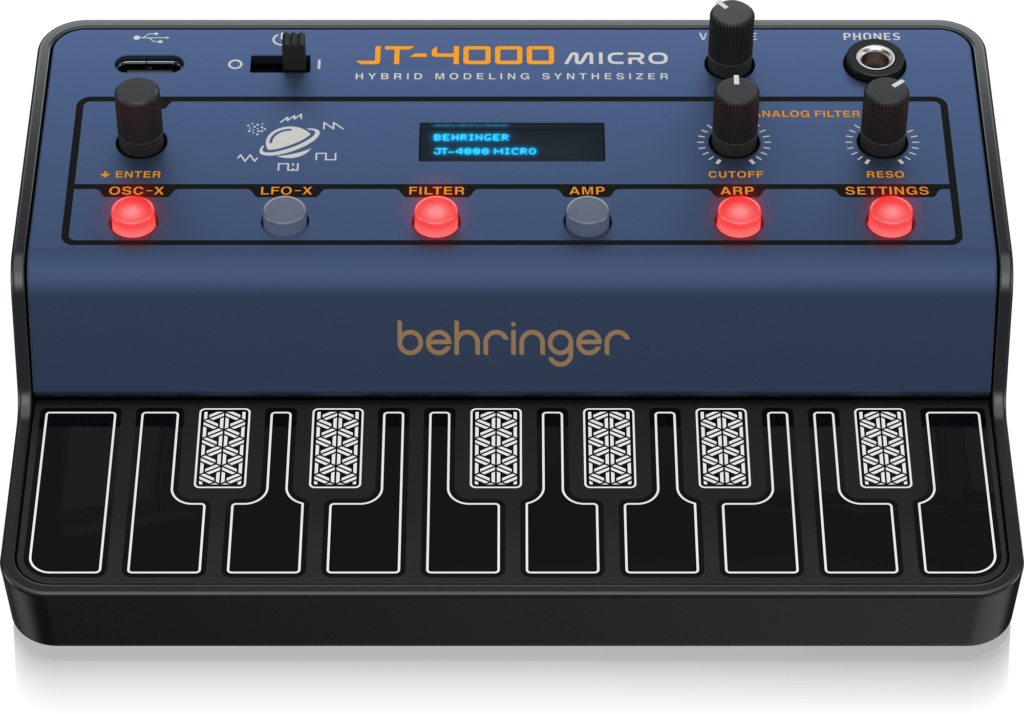Hi Folks!
Yessss! This is it! The first in the line of Micro Synths that Behringer promised us to release!
So let’s check out what you can do with this 50 quid Synth!
To be honest, the first minutes I had to deal with this new Synthesizer Format, I thought that it would definitely suck. But I promised to test all this Behringer stuff for you. And maybe this time my first impression wasn’t right at all? So without further ado, let’s check it out!
Overview
The basic structure of the JT is clearly laid out. To control it, you dispose of 3 pots for Volume and two for filter and parameter control. Then it has combined push-dial for menu and preset selection and 6 buttons to access the edit sections for the Synthesizer, the Arpeggiator and the global settings.
In the middle of this only 12,5 on 9 cm big instrument, you can spot the tiny display!
And finally there are a USB-C Plug for power and Midi and 3,5 mm Stereo output for phones. To connect to your desk, be prepared to have the right adaptors by the hand!
And finally, not to forget, there is this little keyboard, that allows you to play the sounds.
That’s it for the controls and the connections!
So let’s see how it sounds!
The first for buttons are dedicated to the Synthesizer. Starting from the left you will first find the Oscillator-Section. If none of the buttons are lit, you can now select the 32 preset sounds with the SEL encoder. The Behringer JT-4000 Micro has 4 voices of polyphony.
To edit the Oscillators just open the menu by pressing the OSC-X button.
Now with the Encoder you can select the pages of the Oscillator menu. The two knobs on the right now serve to edit the parameters of each page.
For the oscillators there are 7 pages. It starts with the waveform of oscillator one. Select between Triangle, Square, PWM, SAW, Supersaw, FM and Noise.
When you select PWM you can change the pulse width with the right knob. And with the Supersaw you can change the detune. But note, that Supersaw on Oscillator One disables the Oscillator 2! FM allows you to dial in feedback.
The second oscillator has Triangle, Square, PWM, Saw and Noise to offer. Each oscillator has it’s own tuning page with coarse and fine tune.
Then there is a page for Portamento and Glissando amount. Even a Ringmodulator is on board. And finally here you can rename your patch!
The second button allows you to edit the two LFOs of the JT-4000 Micro!
Press the button and select the LFO waveform (Triangle, Square & Sawtooth). As a mod destination you have the choice between Oscillator and filter (VCF). But only for both LFOs at the same time. Strange! Please update this!
When you press the Filter button you gain access to an ADSR envelope for the VCF.
DEMO!
The same applies when you press the VCA button. Here you can edit the envelope of the volume.
And this was it for the sound! You see: It’s not hard to understand and just a bit fiddly to use. But otherwise a real Synthesizer with an astonishingly fat sound.

The next button that you can press is the ARP. And of course it opens the arpeggiator menu.
No paradox of choice here. Directions: Up, Down & UpDown. Tempo (only if it’s not externally synced!).
The resolution marked as scale. And you can even dial in a swing factor! Cool!
On the last page you can decide whether the Arp runs on his own clock or if it gets external MIDI Clock via the USB port.
The final button on the right hides some global parameters like the octave of the internal Micro Keybed, the Modulation selection between Arp and Keyboard, and the retrigger of the VCF Envelope.
Then you have settings for the transmit and receive MIDI Channel, for the Velocity control and for transmitting and receiving SysEx Data for the presets. Also a factory reset might be executed here.
And finally to save a patch, leave all the menus and simply press on the encoder dial. Done.
Final Thoughts:
For sure, this might be the smallest and the cheapest polyphonic synthesizer on the market! But it’s certainly not the one with the worst sound! That would simply be unfair to say. And if it sounds like a Roland JP-8000 or not, is really not the point here.
Of course the form factor makes operation quite fiddly and specially for elderly people like me it can be difficult to read the microscopic display. Also if you have Arthritis in your fingers, or you simply are a gross motorist you should better chose another model with nice big knobs!
But otherwise it’s a surprisingly complete Synthesizer, with all the features you would find in a bigger one. So the last question would be: Who needs a Micro-Synthesizer like Behringer JT-4000? Does it make sense at all? What could be a setup with the perfect use case for the Micro? I would like to hear your suggestions! So please leave a comment!
And if you want to buy one, just click on the Affiliate-Link to Thomann down in the description. Maybe you'll get one at some point! Good luck and thanks for your support!
Apropos: Alle Behringer-Geräte, die auf diesem Kanal vorgestellt werden, habe ich mit meinem eigenen Geld gekauft! Es sind also keine Manipulationen oder andere Interessen an dieser Review beteiligt!
Und wie immer freuen wir uns, wenn du dir die Musik anhörst und vielleicht sogar kaufst, die wir hier in unserem bescheidenen Heimstudio produzieren. Schau dir unser Label auf Bandcamp an!
So thanks for your time! I hope you enjoyed the video and if you did so, leave us a like and don’t forget to subscribe to be sure not to miss the next video!
See you in the next one! Peace!
